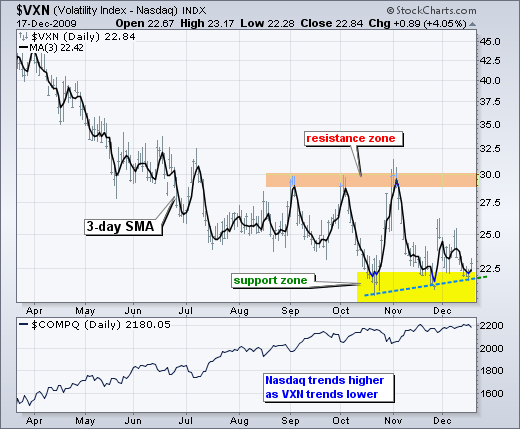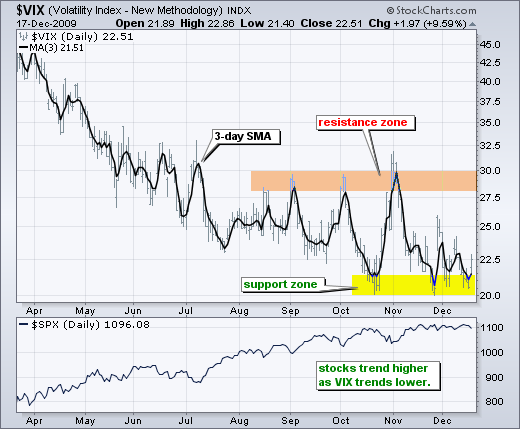While the S&P 500 and Nasdaq bump resistance from their October-November highs, the S&P 500 Volatility Index ($VIX) and Nasdaq 100 Volatility Index ($VXN) are finding support near their October-November lows. These volatility indices are negatively correlated with the stock market. Stocks have been moving up as volatility moves lower. As far as I am concerned, both volatility indices are trending lower and this is still positive for stocks. At what point does volatility indicate enough complacency that will foreshadow a market top? This discussion continues after the jump.
 The chart below shows the S&P 500 Volatility Index ($VIX) over the last 3 1/2 years. There are three ranges noted on the chart. Bull market volatility ranged from 10% to 19%, bear market volatility from 16% to 33% and crisis volatility from 35% plus. Complacency levels in 2006 and early 2007 were in the 10% area. The VIX bounced off the 10-11% area from November-2006 to February 2007, but the S&P 500 did not peak until July 2007. Notice that this peaked occurred with a rather sharp divergence in the VIX. The VIX formed a higher low in April as the S&P 500 formed a higher high. Even though SPX moved higher from April to July, the VIX indicated that fear was also on the rise from April to July. We have yet to see such a divergence in the VIX. Perhaps more importantly, the VIX is still within the bear market range and remains above 20%. VIX has yet to even reach the prior bull market range or show the level of complacency that existed in early 2007.
The chart below shows the S&P 500 Volatility Index ($VIX) over the last 3 1/2 years. There are three ranges noted on the chart. Bull market volatility ranged from 10% to 19%, bear market volatility from 16% to 33% and crisis volatility from 35% plus. Complacency levels in 2006 and early 2007 were in the 10% area. The VIX bounced off the 10-11% area from November-2006 to February 2007, but the S&P 500 did not peak until July 2007. Notice that this peaked occurred with a rather sharp divergence in the VIX. The VIX formed a higher low in April as the S&P 500 formed a higher high. Even though SPX moved higher from April to July, the VIX indicated that fear was also on the rise from April to July. We have yet to see such a divergence in the VIX. Perhaps more importantly, the VIX is still within the bear market range and remains above 20%. VIX has yet to even reach the prior bull market range or show the level of complacency that existed in early 2007.

*****************************************************************

About the author:
Arthur Hill, CMT, is the Chief Technical Strategist at TrendInvestorPro.com. Focusing predominantly on US equities and ETFs, his systematic approach of identifying trend, finding signals within the trend, and setting key price levels has made him an esteemed market technician. Arthur has written articles for numerous financial publications including Barrons and Stocks & Commodities Magazine. In addition to his Chartered Market Technician (CMT) designation, he holds an MBA from the Cass Business School at City University in London.
Learn More






